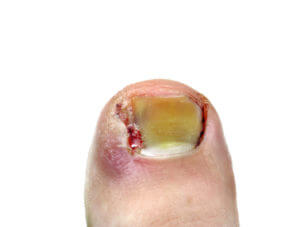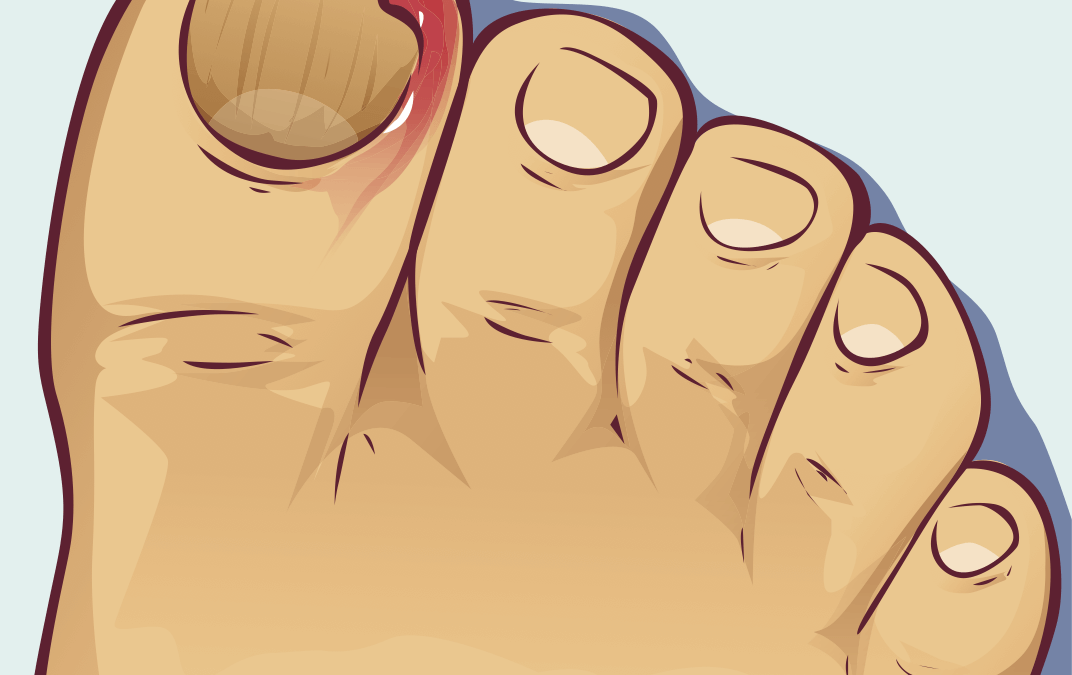Ingrown Toenails
The myths and facts surrounding IngrownToenails could not have been better presented when Mark Wahlberg described his nail on national TV with Ellen DeGeneres. This was obviously that sort of condition that was going to achieve a ‘high yuck factor’! Wahlberg who had flown in for the interview with his nail problem and was asked by DeGeneres,

ingrown toenails
‘Are you shot up with pain stuff?’ He responds, ‘It’s worn off now!’ ‘So now you are feeling it?’‘I’m feeling it,’ he replies to an audience packed with excited ladies.‘The energy’ however is helping him, he explains to DeGeneres. Publicity and the nail are bedfellows, often for the wrong reason. The blunt if not misinformed joke is a reference relating to disability. Perhaps ingrown toe nails shares a similar comedic fate as with bunions. However, I have had an ingrown toenail, albeit mild compared to many of my patients. I do know the inconvenience and discomfort is far from funny.
Whilst training I was informed by one lecturer that you could, in fact, die from an ingrowing toenail. This was stretching the truth by more than a mile. The only way you can die from such a condition is IF you develop a rapidly spreading infection through cellulitis and septicaemia. Sadly this did in fact happen to a 17 year old male when the local casualty officer in Australia failed to see his patient had an ingrown toe nail. The boy, barely into adulthood which much to live for died. Those with poor immunity are at greatest risk and include patients being treated with powerful drugs to suppress cancer cells. We are reminded that immunity is about having sufficient specialist defense cells to ward off disease.
Naming the beast
The ingrown toenail has a number of names. Ingrown toenails are the commonest and suggest part of its origin is growing into the flesh. If you are playing scrabble or want to impress others, you could say I have an onychocryptosis(on-ee-koh–kryp–toh-sis). IGTN for ingrowing toenail is the shorthand version we in the health care professions like to use. The problem here is that IGTN has many appearances and three types of nail pain associated with IGTN can be described. In hands we see the ‘Whitlow’, the skin on one or other side of the nail bed is inflamed and painful. A small amount of white discharge (pus) may be visible. I will leave the NHS website to explain the origins of Whitlow (click on NHS) which can form something similar but also has other origins. Paronychia refers to the inflamed skin around the nail and common to both toe and finger, so Whitlow just adds a name to provide further confusion. To really appreciate the three toe types of IGTN we need to know a bit of anatomy. Don’t worry I will keep it simple.
Variations of ingrown toenails
The hard nail is made from packed cells called keratin and sits on the flat end of the toe. It has a groove down each side. The grooves form gutters that we call sulci (sulk-eye) or sulcus if the singular is used. IGTNs are problems that arise in the sulci. The nail builds around the groove and creates a small area of inflammation. This arises due to one of three factors.
- Nail shape (tight curvature),
- Breach of the skin layer
- A skin bridge forming from nail to groove.
Avoiding pain
 You should not experience more pain than needed as you would expect from dental treatment. If the clinician is unable to provide an anaesthetic, then ask to see someone who can provide this service. Only registered people trained as podiatrists or medically qualified people can provide local anaesthetics. All registered podiatrists are trained in using local anaesthetics since 1988 onwards. Pain is the give away; tenderness to touch. The red swollen component shows that it will not improve without treatment. A discharge implies the damage is increasing. The lack of healing then is demonstrated by the appearance of the cherry red bulge. The larger the bulge the greater the chronic state. Chronic is our medical language means over a time period nothing improves and the conditions smoulder without improvement. The cherry red bulge is known as hypergranulation.
You should not experience more pain than needed as you would expect from dental treatment. If the clinician is unable to provide an anaesthetic, then ask to see someone who can provide this service. Only registered people trained as podiatrists or medically qualified people can provide local anaesthetics. All registered podiatrists are trained in using local anaesthetics since 1988 onwards. Pain is the give away; tenderness to touch. The red swollen component shows that it will not improve without treatment. A discharge implies the damage is increasing. The lack of healing then is demonstrated by the appearance of the cherry red bulge. The larger the bulge the greater the chronic state. Chronic is our medical language means over a time period nothing improves and the conditions smoulder without improvement. The cherry red bulge is known as hypergranulation.
In adolescent boys and girls the occurrence is not dissimilar today as both carry out similar activities and wear trainers a good deal of the time. Boys do have the additional unpleasant odour called bromidrosis or pongy feet) more frequently than girls. The smell that arises comes from the bacteria living within the sweat and producing chemicals which form the smell. Fresh sweat on skin does not smell.
Antibiotics do not cure the ingrown nail
Self-management of the ingrown toe nail is not always possible. Antibiotics are not the correct treatment but will clear up infection temporarily. Nail eruptions will continue until professionally managed. Antiseptics and good cleaning methods are imperative and it is worth having a well stocked first aid kit. While patients should help themselves to solve problems and prevent foot ailments progressing, there is a narrow boundary between self-help and seeking professional help. You can see that onychocryptosis is not a condition that can be managed without experience. At the first sign of inflammation use a sterile plaster and cover the skin and nail for 24-48 hours. If inflammation spreads or the toe swells seek help.
Please download the full article Myths and Facts if you want to have a further guide. Always seek the advice from a registered podiatrist for nail problems.
Thanks for reading ‘Ingrown Toenail’ by David R Tollafield

Published by Busypencilcase Reflective Communications Est. 2015

First published July 2019. Modified 30th March 2021

Recent Comments